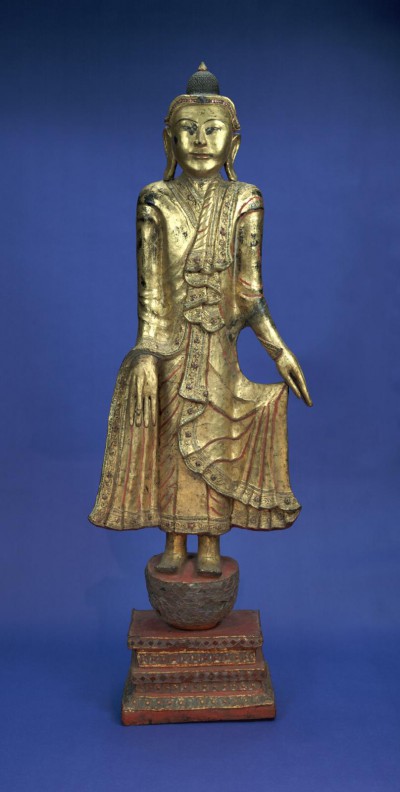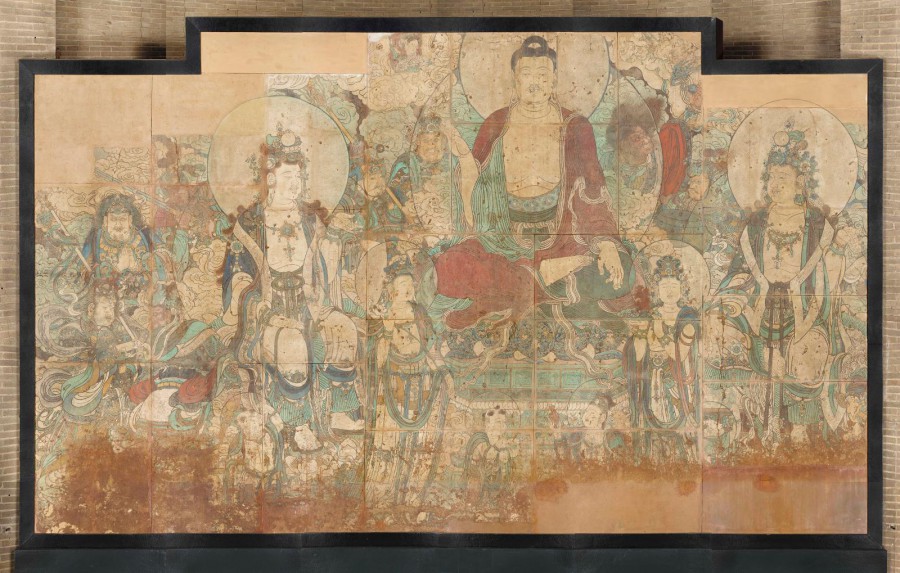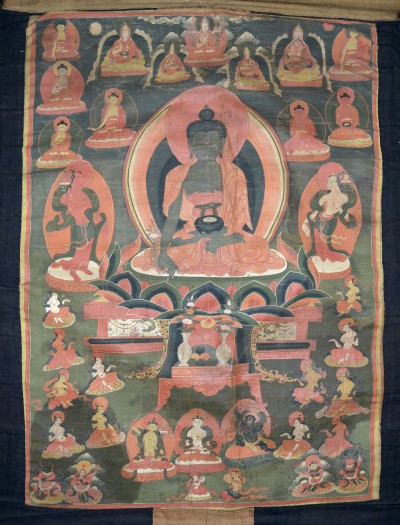The Asian Section is happy to host a guest blog post by C. Pierce Salguero, Assistant Professor of Asian History and Religious Studies at Penn State University’s Abington College. He is the author of Translating Buddhist Medicine in Medieval China, published by Penn Press in 2014.
(Photo selection and captions by Stephen Lang)
MEDICINE IN EARLY BUDDHISM
Knowledge about healing and disease has held a central place within Buddhist thought since the earliest times. Taken collectively, Buddhist perspectives on health, disease, healers, patients, therapies, and bodies are often spoken of by scholars and devotees as “Buddhist medicine.” Over the course of the first millennium CE, Buddhist medicine (if we can borrow that term) spread alongside Buddhism as far as Iran, Mongolia, Japan, and Indonesia. Today, it is the foundation of traditional medicine in Tibet, Thailand, Sri Lanka, and other parts of Asia and has become the object of scientific study under the rubrics of “mindfulness” and “meditation.” At the same time that Buddhist medicine has become a transnational tradition, it has always been reinterpreted locally through the lenses of the many different cultures that have adopted it.
Although never its primary concern, the Pāli Buddhist Canon (first written down in first century BCE Sri Lanka) contains a great amount of material pertinent to the history of Indian medicine. Medical ideas appearing in the Pāli Canon include the doctrines of the Four Elements (Earth, Water, Fire, and Wind) and the associated doṣa (defects or humors). These became foundational to both Buddhist and Āyurvedic medicine, and are also similar to concepts from Greco-Roman and Islamic medicine, although each tradition would interpret these doctrines in unique ways.
There is every indication that medicine, nursing, and hospice was practiced among the early Indian monastic communities. The monastic codes, or Vinaya, of the various Buddhist schools contain guidelines and narrative descriptions of medical procedures such as herbal and mineral treatments, dietary regulation, and even surgery. Additionally, the accounts of Chinese pilgrims written in the mid-first millennium CE tell us that medicine was an important part of the training of monks at the Indian mahāvihāras, the great monastic “universities.” Nālandā, for example, was famed as an international center for medical training, and monastics from all over Asia came to study in the seventh and eighth centuries.
BUDDHIST MEDICINE IN TRANSNATIONAL CONTEXT
The spread of Buddhism to other parts of Asia in the first millennium CE was one of the most significant examples of sustained cross-cultural exchange in world history. This transmission included the introduction of a large amount of medical material that was embedded within Buddhist writings. Influential aspects of Buddhist medicine included doctrines such as the Four Elements and tridoṣa, Indian and Southeast Asian pharmaceuticals, Buddhist medical deities (including their hagiographies, rituals, and iconography), medical spaces such as dispensaries and hospices within monastic complexes, the ideal of monks as efficacious healers, and several core medical metaphors that structured Buddhist medical thought in places as far away as Tibet, China, Japan, Mongolia, and Southeast Asia.

Medical knowledge explicitly associated with Buddhism lost favor in India, replaced by Āyurvedic and Tantric healing traditions associated with Hinduism, and other parts of the Buddhist world—like northwestern India, Pakistan, Afghanistan, Central Asia, and Indonesia—lost the tradition when converting to Islam. Nevertheless, Buddhist medicine remains vitally important, in many other parts of Asia today.
Although core Indian medical doctrines largely did not prevail over the long term in East Asia, Buddhist healing deities such as Guanyin/Kannon and the Medicine Buddha, and the rituals associated with them, remained very important in that region of the world. In a recent book I wrote, Translating Buddhist Medicine in Medieval China, published by Penn Press in 2014, I give a general outline of the wide variety of doctrines, ritual practices, and medical metaphors that prevailed in Chinese Buddhism in the medieval period. As medieval Chinese Buddhism was formative for Japanese and Korean tradition, many of these elements are shared across East Asia.

Among the major Buddhist-influenced medical traditions in Asia, Tibetan medicine is perhaps the most well known. The most influential Tibetan medical treatise is the compilation known as the Four Tantras(Gyushi), which was commonly held to be a teaching by the Medicine Buddha. Developed between the seventh and twelfth centuries, this text synthesized Buddhist and secular Indian medical material, self-consciously integrating this with ideas from the indigenous Tibetan Bōn tradition, as well as with Chinese, Central Asian, Persian, and even Greco-Roman medicine. The Tibetan Tripitaka also contains translations of 22 Indian medical writings, many of which are now no longer extant in Sanskrit. These treatises cover topics as varied as internal medicine, pediatrics, gynecology and obstetrics, toxicology, surgery, pharmacology, alchemy, and veterinary medicine.
Traditional medicine in Thailand also is highly indebted to Buddhism. The modern edition of the Thai medical canon, the Study of Medicine(Phaetthayasaht songkhro), compiled in the nineteenth century, contains numerous texts that suggest important continuities with Buddhist doctrines. This material gives the reader the distinct impression that it originated in multiple geographical and cultural contexts and entered Thailand over the course of many centuries. Some of the sources of Thai medical knowledge certainly included the Pāli Canon and Āyurvedic treatises; however, a significant portion seems to reflect Buddhist knowledge originating in India but not attested in other sources. (The University of Pennsylvania and National Library of Laos have jointly launched the Digital Library of Northern Thai Manuscripts at www.lannamanuscripts.net, a collection that includes numerous texts related to both Buddhism and healing.)
Khmer, Sri Lankan, Burmese, and other Southeast Asian medical traditions are similarly diverse windows on the wide range of Indian medical knowledge transmitted to the region via Buddhism. There are important discrepancies among all of these traditions on the details of even the most basic doctrines. However, these traditions tend to revolve around the doctrines of the Four Elements, the three doṣa, the division of medicinal foods by flavors (options range from three to ten categories), and the understanding that the Elements are specifically affected by the fluctuations of the seasons, personal regimen, environmental factors, and specific pharmaceutical interventions. Differences between these traditions reflect both the diversity of the Indian transmissions as well as the localization of received knowledge in different parts of Asia. Taken as a whole, however, the received texts, archaeologically recovered manuscripts, and contemporary medical traditions discussed here tell us in no uncertain terms that Indian medical doctrines and practices circulated widely and were highly influential throughout Asia, and that Buddhism played a major role in their dissemination and acceptance across the region.


BUDDHISM AND MEDICINE IN THE CONTEMPORARY WORLD
As Buddhism is now spreading Westward, the association between Buddhism and medicine has once again been front and center in Buddhist cross-cultural exchange. Scientific research into the mental and physical benefits of Buddhist meditation has been enthusiastically undertaken under the aegis of organizations such as the Mind & Life Institute, various centers for the study of Mindfulness-Based Stress Reduction (MBSR), and by individual researchers in psychology, psychiatry, neurology, and other disciplines. The University of Pennsylvania Mindfulness, Stress & Health Lab (http://www.mindfulnesslab.org), for example, is currently conducting research into how mindfulness meditation “can improve symptoms of stress, depression, and inflammation in adults living with HIV.” Published medical studies done by Penn researchers and other scientists have already demonstrated the benefits of meditation, notably including the reduction of stress, addiction, and depression, the increase in memory and attention, the slowing of the aging process, and the increase in one’s general sense of well-being. Many of the popular writings on Buddhism available at bookstores, in magazines, and online in the English language mention now highlight such benefits among the chief reasons for taking up Buddhist practice. As Buddhism is translated into scientific and psychological language to increase its appeal to modern audiences, these new ways of talking about the tradition are now playing a major role in how Asian practitioners see Buddhism as well.
As always, translation into a new language and conceptual world brings both gains and losses. The process of “modernization” represents yet another example of the ease with which Buddhist ideas are translated into new cultural and social contexts, as well as the willingness of Buddhist leaders, authors, and practitioners to emphasize the practical benefits of Buddhism in accessible terms in order to gain legitimacy and attract converts. Of course, it also underscores how central the alleviation of all forms of suffering—especially the suffering of illness—remains to the Buddhist tradition as a whole, and how ecumenical Buddhists are in their embrace of this mission.
——
Pierce Salguero is an interdisciplinary humanities scholar interested in the role of Buddhism in the cross-cultural exchange of medical ideas worldwide. He has a Ph.D. in the History of Medicine from Johns Hopkins School of Medicine, and is Assistant Professor of Asian History and Religious Studies at Penn State University’s Abington College, in the Philadelphia area. He is the author of Translating Buddhist Medicine in Medieval China, published by Penn Press in 2014. See www.piercesalguero.com.
Stephen Lang is the Lyons Keeper of Collections in the Asian Section at the University of Pennsylvania Museum of Archaeology and Anthropology. He has a degree in Anthropology from Cornell University with an interest in the visual and material culture of East Asia. His blog entries focus on the Asian collections at the Museum.
No comments:
Post a Comment